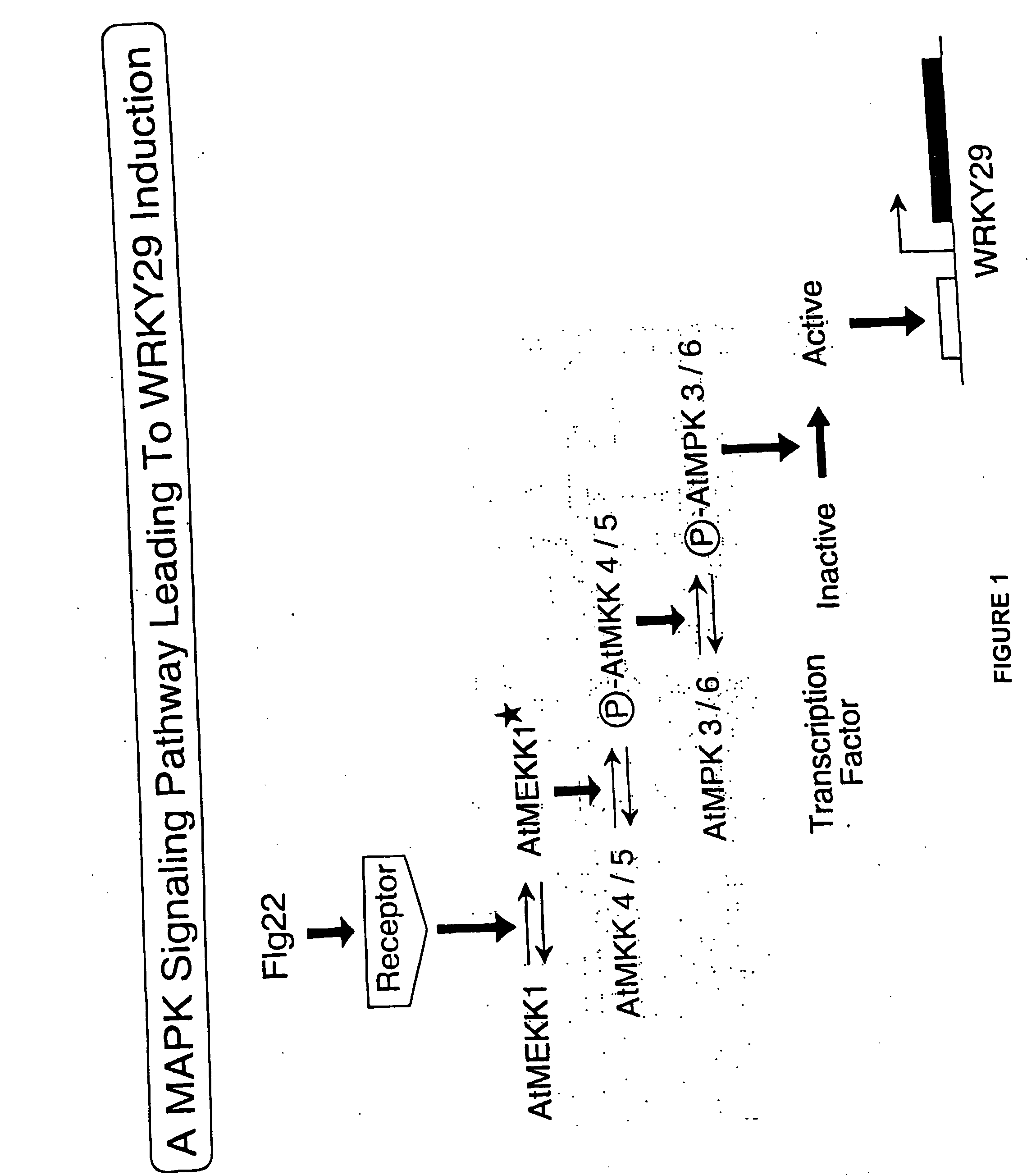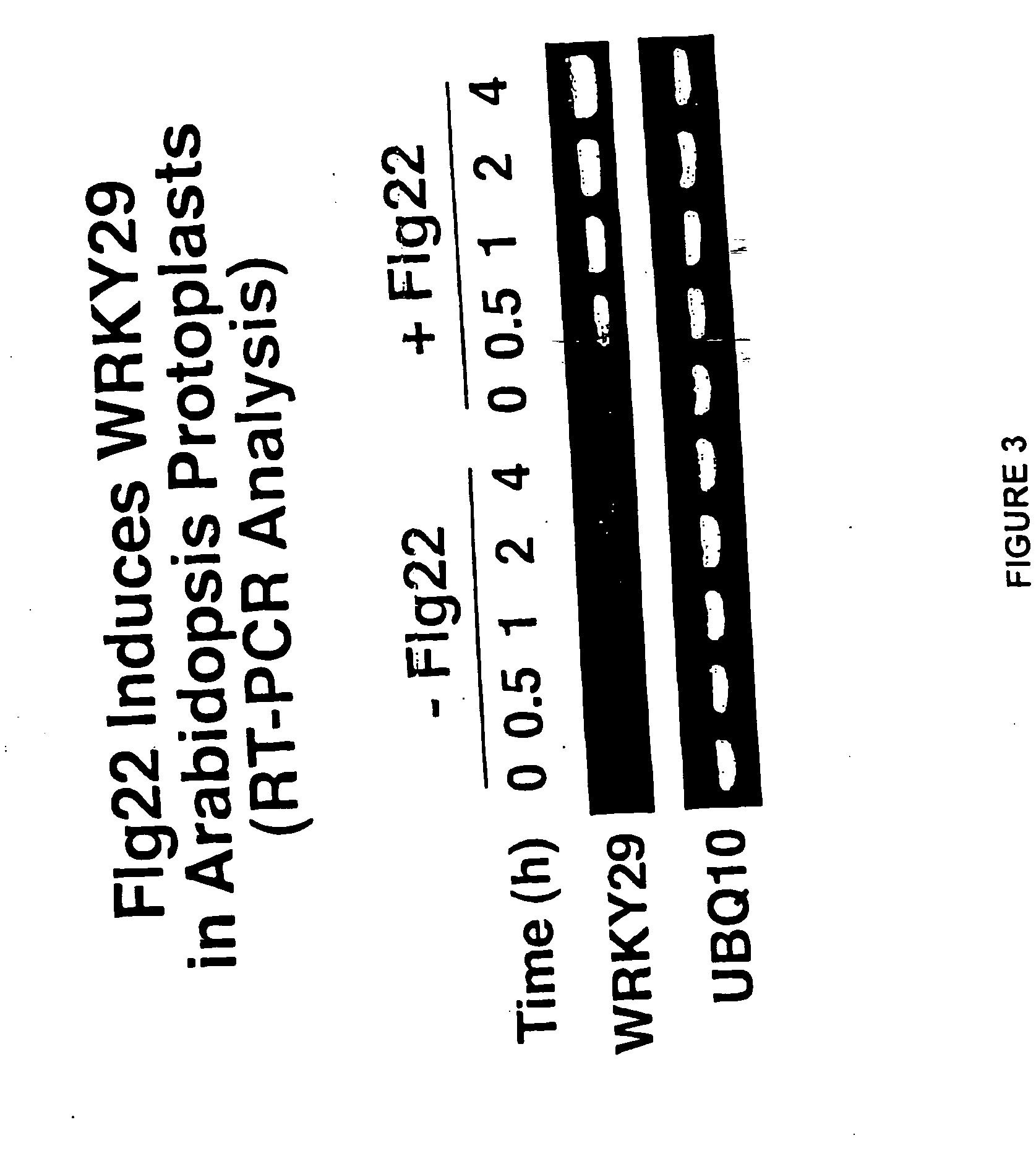Master activators of pathogen responsive genes
a technology of master activators and pathogens, applied in the field of plant disease resistance, can solve the problems of little progress in the identification and analysis of key regulators of pathogen resistance, and achieve the effects of improving quality and yield, increasing production efficiency, and high quality
- Summary
- Abstract
- Description
- Claims
- Application Information
AI Technical Summary
Benefits of technology
Problems solved by technology
Method used
Image
Examples
example 1
Cellular Systems for Functional Analysis of Plant Defense Gene Regulatory Pathways
[0071] Two protoplast transient expression systems, such as the maize (Sheen, 1999) or Arabidopsis (Kovtun et al, Proc. Natl. Acad. Sci., USA 97:2940-5, 2000) leaf protoplast systems, are useful for examining regulation of plant defense mechanisms. Technical advances in these two systems, including high transformation efficiency by electroporation (up to 75%) or by PEG fusion (up to 80%), specificity of reporter gene regulation, the use of improved green-fluorescent protein (GFP) as a vital and visual reporter (Chiu et al., Curr. Biol. 6, 325-30, 1996), PK and PP activity assays (Kovtun et al., Nature 395:716-720, 1998; Sheen, Proc. Natl. Acad Sci., USA 95:975-980,1998; Kovtun et al., Proc. Natl. Acad. Sci., USA 97:2940-5, 2000), and expression of putative signaling molecules with epitope- or GFP-tag and their detection by immunoprecipitation and confocal microscopy, make them especially attractive to...
example 2
Flg22-induced Responses in Arabidopsis Protoplasts
[0073] Activation or repression of the transcription of specific reporter genes can be used to monitor activation of particular signaling pathways. For example, Flg22 has been found to induce the expression of the GST1, PAL1, and PAL2 promoters. MAPK activation was demonstrated in Arabidopsis protoplasts isolated from 4-week-old leaves. Here Flg22 or distilled water was added to the protoplasts and samples were assayed at different times to determine relative promoter activity. Defense gene promoters fused to a luciferase reporter gene were introduced into Arabidopsis protoplasts. The protoplasts were incubated for 16 hours in the presence of Flg22 and / or staurosporine, and luciferase activities were assayed. The number of viable cells in each sample was also determined at the end of the incubation by Evans blue staining and promoter activity was represented as a luciferase activity per viable cell. In the Flg22 experiment, the indu...
example 3
Flg22 induces WRKY29 in Arabidopsis Protoplasts and a MAPK Signal Cascade
[0074]Arabidopsis protoplasts treated Flg22 were evaluated for the expression of WRKY29 using standard reverse-transcription polymerase chain reaction analysis (RT-PCR). As shown in FIG. 3, Flg22 was found to induce WRKY29. The structure of WRKY29 is shown in FIG. 2. To determine whether, MAP kinase signaling is involved in WRKY29 induction, the induction of WRKY29 was monitored in the presence of U0126, a MAPKK inhibitor. RT-PCR analysis of WRKY29 induction showed that U0126 suppressed WRKY29 induction. Furthermore, Flg22 was found to activate MBP kinases. Further demonstrating the involvement of a MAPK cascade, mouse MAPK phosphatase l was found to suppress WRKY induction by Flg22.
PUM
| Property | Measurement | Unit |
|---|---|---|
| Fraction | aaaaa | aaaaa |
Abstract
Description
Claims
Application Information
 Login to View More
Login to View More - R&D
- Intellectual Property
- Life Sciences
- Materials
- Tech Scout
- Unparalleled Data Quality
- Higher Quality Content
- 60% Fewer Hallucinations
Browse by: Latest US Patents, China's latest patents, Technical Efficacy Thesaurus, Application Domain, Technology Topic, Popular Technical Reports.
© 2025 PatSnap. All rights reserved.Legal|Privacy policy|Modern Slavery Act Transparency Statement|Sitemap|About US| Contact US: help@patsnap.com



